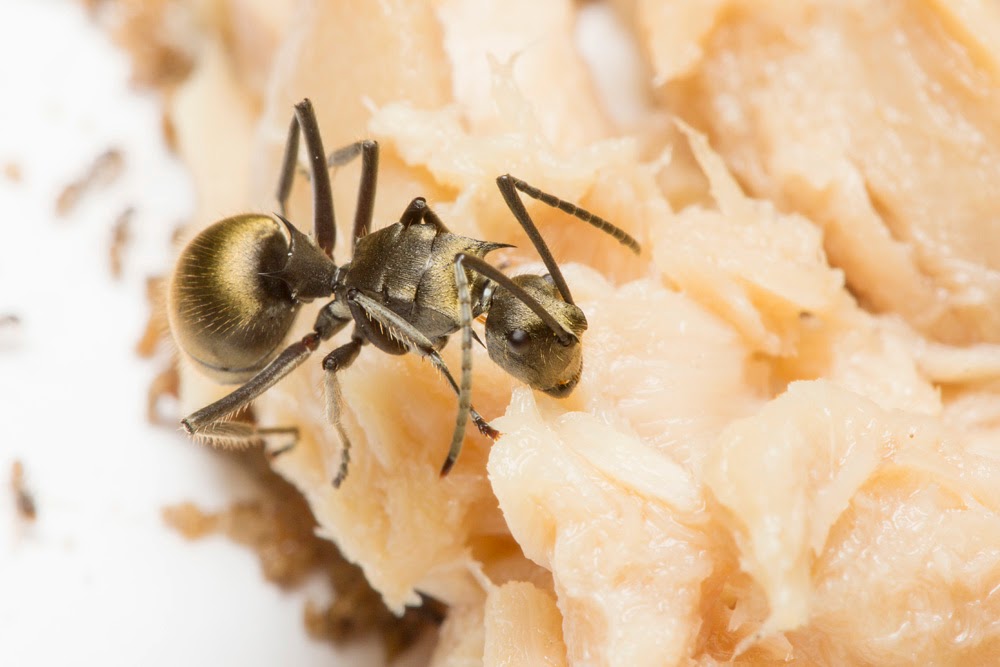An Informal List of the Ants of Kent Ridge (and adjacent green areas)
Kent Ridge has a myriad of ant species that forage about on the ground. These are ant species obtained by baiting with honey, tuna and peanut butter. The ants are also given a size "score" based on total length: tiny (<=3mm), medium (>3mm), large (>9mm).
Subfamilies represented: Myrmicinae, Ponerinae, Dolichoderinae, Formicinae
Photographs by Eunice S.
If there are any misidentifications you feel strongly about, please feel free to comment on this blog and I will review it. As much as possible, I've tried to use the available taxonomic keys to identify them.
Anoplolepis gracilipes (Smith 1857) Yellow Crazy Ant
Size: Medium
Nesting habit: in cracks, in the ground (opportunistic)
Camponotus cf. auriventris Emery 1889
Size: Medium
Nesting habit: excavates and nest in soil
Camponotus sp. 2 [cf. maculatus-group]
Size: Large
Nesting habit: Unsure
Camponotus sp. 3 [cf. albosparsus]
Size: Medium
Nesting habit: Nests in the ground.
[Camponotus sp. 4 is part of another inventory]
Camponotus sp. 5
Size: Large
Nesting habit: Likely arboreal.
Plagiolepis cf. exigua Forel 1894
Size: small
Nesting habit: In the ground.
Crematogaster (Orthocrema) biroi bandarensis Mayr, 1897 [ID by Shingo Hosoishi, Crematogaster expert]
Size: Medium
Nesting habit: Very likely to be in the ground (known from the subgenus)
Crematogaster (Physocrema) sewardi Forel 1901 [ID by Shingo Hosoishi, Crematogaster expert]
http://www.antwiki.org/wiki/Crematogaster_sewardi
Size: Medium
Nesting habit: Likely arboreal but not fully ascertained.
Philidris sp. 1
Size: Medium
Nesting habit: Arboreal
Dolichoderus thoracicus (Smith 1860)
Size: Medium
Nesting habit: Arboreal, lives in hollow branches
Meranoplus bicolor (Guerin-Meneville 1844)
Size: Medium
Nesting habit: In the ground. Excavates its own nest.
Monomorium monomorium Bolton 1987
Size: Small
Nesting habit: Uncertain. Likely in the ground.
Oecophylla smaragdina smaragdina (Fabricius 1775)
Size: Large
Nesting habit: Uses leaves to make nest arboreally.
Nylandaria sp.
[corrected by James Trager, Myrmecologists Facebook forum]
Size: Medium
Nesting habit: unknown
Pheidole cf. parva Mayr 1865
Size: Small - Medium
Nesting habit: in the ground
[No photographs for Pheidole sp. 2 and Pheidole sp. 3]
Pheidole sp. 4
Size: Small - Medium
Nesting habit: in the ground
Pheidole sp. 5
Size: Medium
Nesting habit: unknown, probably in the ground
Pheidologeton (or Carebara sensu Fisher 2014) diversus (Jerdon 1851)
Size: Medium - Large
Nesting habit: in the ground and on the surface (but covered with sand)
Polyrhachis cf. proxima Bingham 1903
[not really sure if illaudata or proxima, but compared images on AntWeb and seem closer to proxima]
http://www.antweb.org/description.do?rank=species&name=proxima&genus=polyrhachis
Size: Large
Nesting habit: in the ground
Polyrhachis cf. abdominalis Emery 1896 [as suggested by Gordon Yong]
http://www.antweb.org/description.do?rank=species&name=abdominalis&genus=polyrhachis
Size: Large
Nesting habit: in bamboo
Tapinoma cf. melanocephalum Forel 1895
[corrected by Jim Wetterer, Myrmecologists Facebook forum]
Size: Medium
Nesting habit: in cracks of the ground (opportunistic)
Tetramorium (tortosum species-group) sp. 1
Size: Medium
Nesting habit: in the ground
Diacamma cf. rugosum (Le Guillou, 1842)
Size: Large
Nesting habit: in the ground, excavates its own nest
Odontomachus rixosus Smith 1857
Size: Large
Nesting habit: in the ground
Note: not present in Kent Ridge, for comparison purposes
Odontomachus simillimus Smith 1858
Size: Large
Nesting habit: in the ground, usually at the base of trees
Odontoponera denticulata (Smith 1857)
[ID suggested by Wendy Wang, pers. comm. but haven't had the chance to examine the specimen properly; the antennal scape is quite short, dark integument seems to suggest it is denticulata but its rugae is fine, suggesting its transversa, have to check eye size, incision at petiole and propodeal denticles; also I do think both species (transversa and denticulata) exist in Singapore as I've gotten reddish forms found in forests and this darker form, found in urban areas]
Size: Large
Nesting habit: in the ground, excavates its own tunnel in the soil



+sp.+3+IMG_2290.jpg)



+sp.1+IMG_2355.jpg)














+sp.2+IMG_2339.jpg)




No comments:
Post a Comment